Bulletin – May 1992 Bank Interest Rate Margins
- Download 78KB
Bank interest rate margins – the difference between what interest rates banks borrow at and what they lend at – have been the subject of much discussion in recent years, especially since interest rates generally began to fall in early 1990. Concern about the behaviour of margins was an important stimulus to the establishment, in October 1990, of the Parliamentary inquiry into banking which reported in November 1991.[1]There was then, and remains, a widespread perception that banks have widened their interest margins by failing to pass on to borrowers the full extent of falls in their funding costs. On the other hand, the evidence available to the Reserve Bank suggests that there has been no general widening of margins in recent years. This article presents that evidence.
Simple Measures of Margins
Statements about behaviour of interest rate margins are often made with reference to a simple comparison of one lending rate and one deposit rate. The most common examples are:
- the difference between the business indicator lending rate and the bank bill/certificate of deposit rate;
- the difference between the business indicator lending rate and the overnight cash rate; and
- the difference between the housing indicator lending rate and a savings account deposit rate e.g. statement savings account.
These sorts of measures have often been used to try to justify claims that bank customers have been disadvantaged by a widening of margins. For instance:
- the gap between business indicator and bank bill rates widened from little more than 1 percentage point in early 1989 to about4 percentage points more recently (Graph 1A);
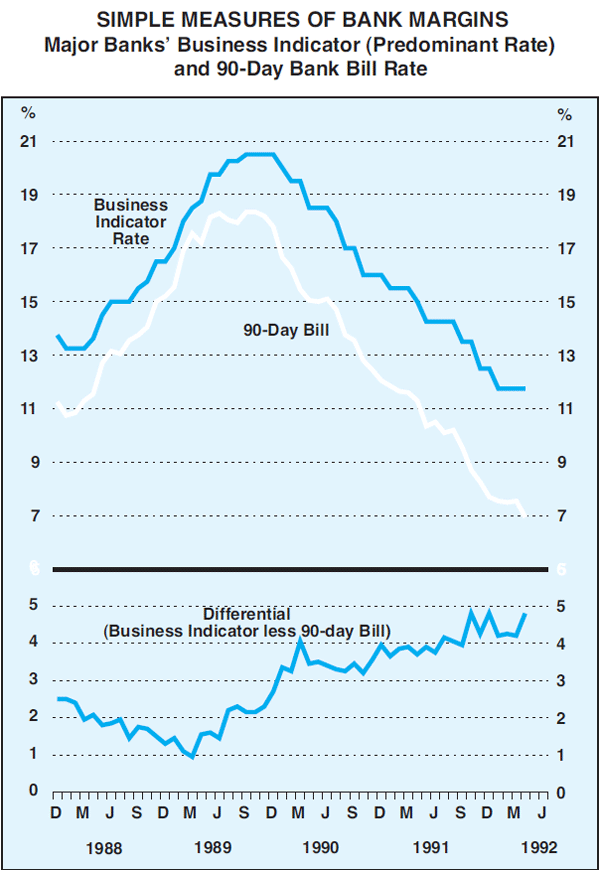
- the gap between business indicator and overnight cash rates has widened from about 2 percentage points in 1988 to about 4 percentage points (Graph 1B); and
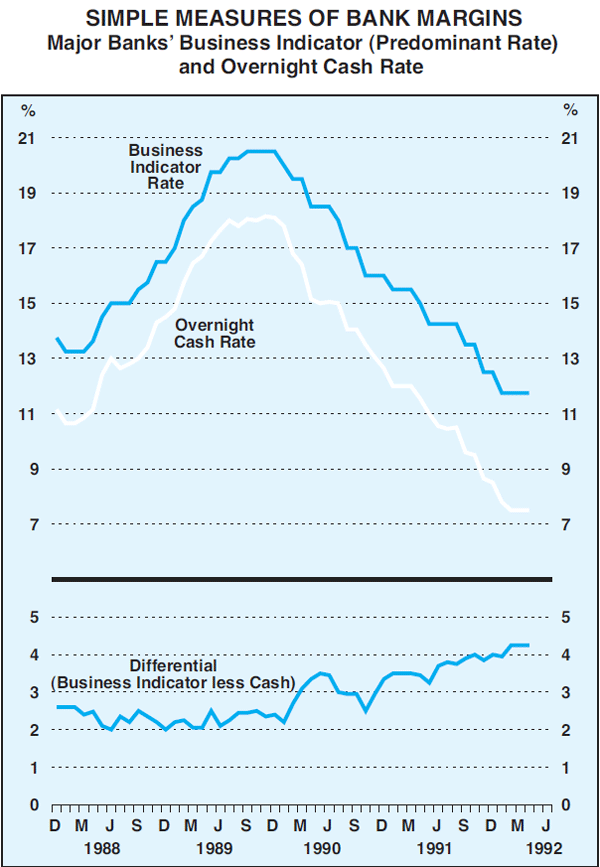
- the gap between housing indicator and statement account deposit rates widened from about 4½ percentage points early in 1988 to as much as 8½ percentage points before receding to 7 percentage points or so more recently (Graph 1C).
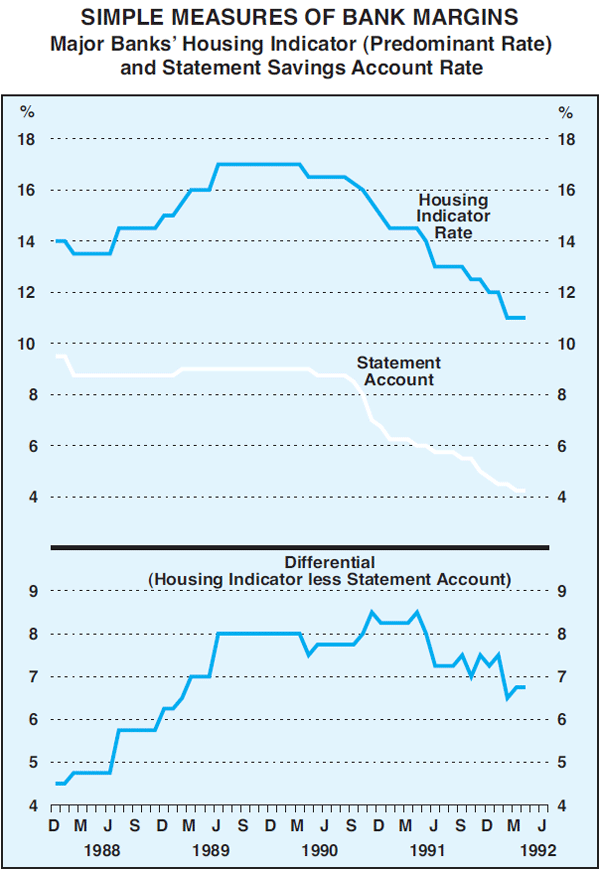
As indicators of margins, however, these measures are simplistic and misleading. Banks have many different types of loans and these are funded by a variety of deposits and other liabilities. No one category of either loans or deposits will necessarily be representative of the full range:
- of all assets, about 35 per cent are loans to business or bank bill acceptances (most of which are for business). Loans to households, for housing and other purposes, account for a little over 30 per cent. The remainder include loans to money market dealers, investments in securities, and loans and investments in foreign currencies (Graph 2A);
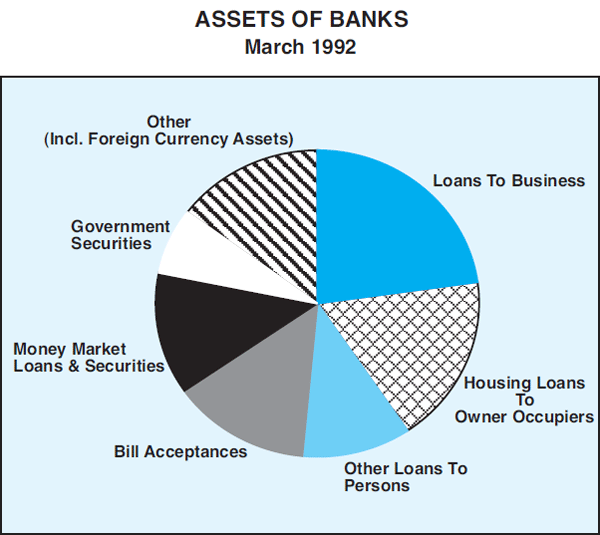
- of all liabilities, about 20 per cent is in traditional current or savings deposits, about the same amount in fixed deposits, and 10 per cent in cash management and call deposits. About 25 per cent is in bill acceptances and certificates of deposit. The remainder includes capital (equity and subordinated debt) and foreign currency borrowings (Graph 2B).
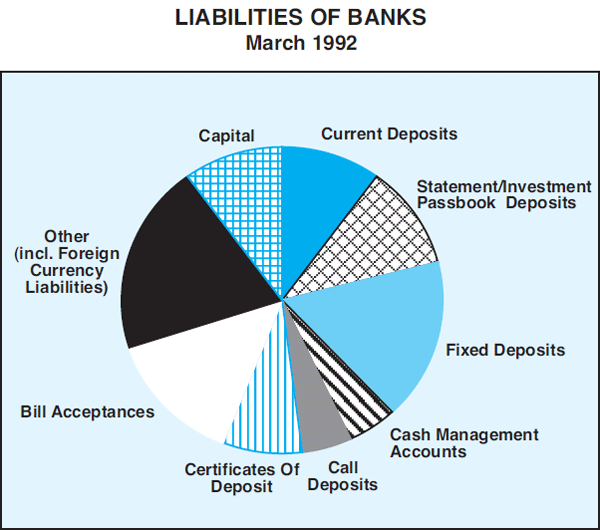
It is clearly not appropriate to take one type of loan, such as housing, and attribute its funding to one type of deposit. In practice, banks operate today by meeting the effective demand for loans at the ruling loan interest rate and then raising liabilities to match the new loans. In the first instance, these liabilities are likely to be raised as call deposits or certificates of deposit – so-called marginal sources of funds – which will subsequently be reduced as and if other liabilities grow to replace them. Thus, the cost to banks of funds for any type of loan is best viewed as the average cost of all their sources of funds, not just any one type of deposit or group of deposits.
A Better Measure: Average Interest Spreads
In order to obtain a representative picture of banks' overall margins, it is necessary to look at average interest rates received and paid. These do not fluctuate as sharply as some indicator interest rates, and certainly by much less than overnight cash rates or bank bill yields which are common measures of banks' cost of funds in the simple comparisons mentioned earlier.
The most useful measure of banks' margins is the average net spread – i.e. the difference between the average interest rate received on all loans and investments (including non-accrual loans) and the average interest rate paid on deposits (including zero-interest deposit accounts) and other interest-bearing liabilities.
On their Australian domestic business, it is estimated that average net spreads for the major bank groups[2] were about 5 percentage points in the first half of the 1980s and about 4.5 percentage points in the second half. In 1990 and 1991, average net spreads fell to 4 percentage points or less (Graph 3).
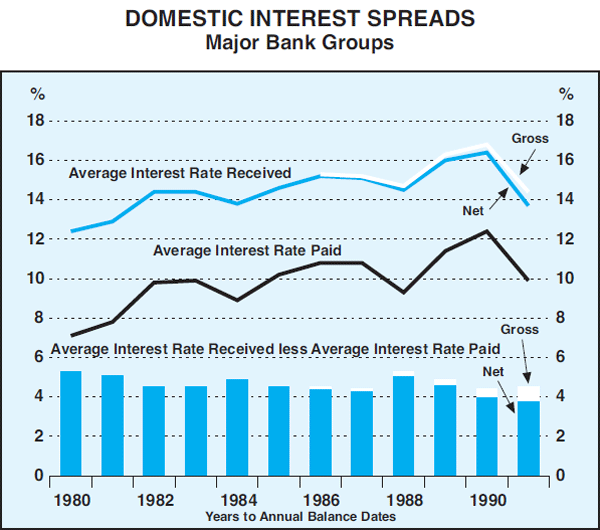
The calculation of average net spreads includes non-accrual loans on which no interest is being earned by banks. The average spread on banks' other loans and investments – the average gross spread – is higher. Even so, average gross spreads for the major banks have not risen over the past few years (Graph 3).
While spreads have been lower on average in the second half of the 1980s, they have not been uniformly so. As the graph shows, spreads increased markedly in 1988 when there were large inflows of low-interest deposits to banks as investors sought security for their savings in the wake of the share-market crash in October 1987. Furthermore, as deposit and loan interest rates change at discrete intervals and not always exactly in step, there can be large swings in spreads over short periods. One example was in mid 1990, when banks appeared slow to reduce their loan interest rates. Although competition among the banks quickly reversed the rise in spreads, this particular episode was one of the triggers for the Parliamentary inquiry into banking which followed.
Distributional Issues
The steadiness of average spreads in recent years shows that, when all customers of the major banks are taken together, there is no evidence that banks have used margins as a means of boosting profitability at the expense of their customers. That does not mean that every customer's experience has been the same – some are better off, some are worse off, and some are, like the average, neither one nor the other.
As a group, depositors have benefitted in the past decade or so from a rise in the average interest rate paid by banks on their balances, especially after allowance is made for inflation. Low-interest accounts – such as current deposits and statement/investment/passbook accounts – have declined sharply from 55 per cent of banks' liabilities in 1981 to about 20 per cent of liabilities in 1991 (Graph 4). There has been a corresponding rise in the proportion of banks' liabilities in term, call and cash management deposits which typically earn higher rates of interest. Even within the ‘low-interest’ accounts, interest rates on some categories have risen over the period.
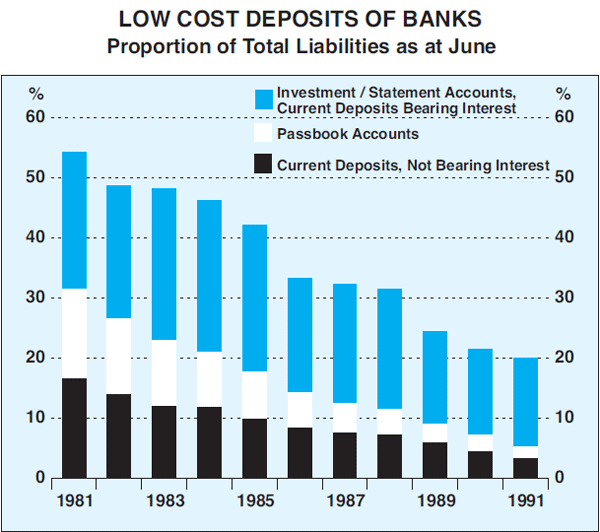
The main reasons for this increase in the interest cost of deposits were:
- savers have generally demanded higher returns than they did in the 1970s – i.e. most interest rates and investment returns tended to be higher in the 1980s, especially in ‘real’ terms; and
- competition among banks saw many new deposit products introduced, usually with more market-related interest rates than had been offered on traditional deposit accounts.
The trend increase in average deposit costs has translated, perforce, into a corresponding trend increase in the average interest rates sought by banks on their loans and other investments (see Graph 3). However, the spread between the average rates received and paid has not increased. What this means is that, on average, borrowers are paying more for their loans than they did a decade or so ago but they are paying not the banks but those people who lend money to or deposit money with the banks.
For borrowers there has been a great diversity of experience with bank interest rates. Those who borrowed for a long term at fixed interest rate have not faced any change in their interest costs over the periods of their loans, although they may face large changes in interest costs if and when they seek to roll over such loans. Most bank lending, however, is at interest rates which can be varied during the term of the loan. On these loans, banks usually follow a two-step procedure in setting the interest rates:
- head office determines indicator rates from time to time in response to movements in market short-term rates, to reflect the general level of interest rates. Many banks have different indicator rates for different categories of business loans, one for owner-occupied housing, one for investment housing, and so on;
- for each business customer, a branch or regional manager typically decides on a margin, to reflect the overall creditworthiness of that customer, to add to the relevant indicator rate. These customer margins are assessed within guidelines provided by head office;
- for each housing or personal loan customer, the bank usually charges the indicator rate although there are sometimes ‘special offers’ for certain customers, such as first-home buyers.
Fees are also relevant. Some, such as application fees or establishment charges, are once-only payments levied when a loan is first arranged. Other fees, such as line fees, are charged continuously over the life of the loan and are, in effect, an additional interest margin.
Indicator rates are set with reference to movements in the banks' cost of funds, with an additional allowance made for costs associated with prudential requirements (non-callable deposits and the Prime Assets Ratio requirement), expected average losses on bad debts for that type of loan, handling charges, a contribution to overhead operating costs, and a return on the capital required to support the loan.
The process of setting a customer's margin above the relevant indicator rate varies with the size of the loan. For small loans (up to $¼ – ½ million), the customer margins are usually determined by branch managers, who assess the credit risk of each proposal, using guidelines laid down by head offices. For medium-sized loans (up to several million dollars), decisions on customer margins may be taken by regional managers. For larger loans, decisions are usually taken at head offices.
For large borrowers, customer margins are usually small – within a range up to about 1 percentage point. The reason margins are small for these customers is that they tend to be large well-established businesses which have a good loan history and ready access to other sources of funds (for example, by issues of securities such as promissory notes, convertible notes, or preference shares) and will generally be prepared to pay only a small premium to an intermediary for finance.
For smaller borrowers, customer margins are wider reflecting the fact that, on average, the risks are greater. Generally, the range is up to 4 percentage points, with an average of about 2 percentage points. Higher rates are usually charged on unapproved borrowings (where, for example, a customer has exceeded the maximum limit on an overdraft) and on loans where the customer is in default.
In recent years, banks have increased the customer margins for some borrowers to reflect changed assessments of the credit risk represented by their loans to those customers. It could be argued, with the benefit of hindsight, that the banks should have applied greater customer margins at the time some loans were made. In any event, experience has shown that banks underestimated the average level of risk in business lending and some reassessment of these risks – and hence of the risk margins built into lending interest rates – was necessary.
Despite considerable publicity suggesting that increases in customer margins have been large and widespread, evidence available to the Reserve Bank suggests that they have been minimal and have had little effect on banks' average interest spreads. Between August 1990 and September 1991, when business indicator rates fell from 17.0 per cent to 13.5 per cent, there was only a small increase in the sizes of customer margins – e.g. the percentage of loans on which the customer margin exceeded 2 percentage points rose from 27 per cent in August 1990 to 31 per cent in September 1991 (Graph 5).
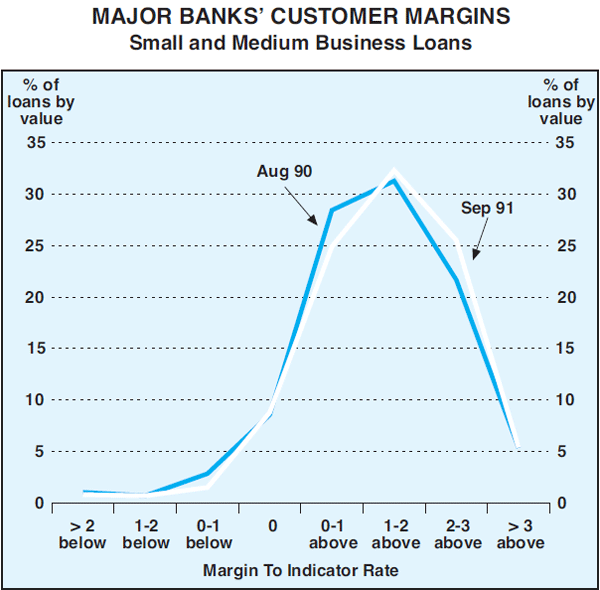
End Piece
Banks are intermediaries which borrow from one section of the community and lend to another. In the normal course, they cannot give their borrowers a larger cut in loan interest rates than their depositors are willing to give to them. Banks must earn reasonable profits if they are to remain viable and be in a position to meet the financing needs of the community in the future. On the other hand, when bank managements make mistakes it is appropriate that their shareholders bear the brunt of this through lower profits and dividends. That is essentially what has been occurring.